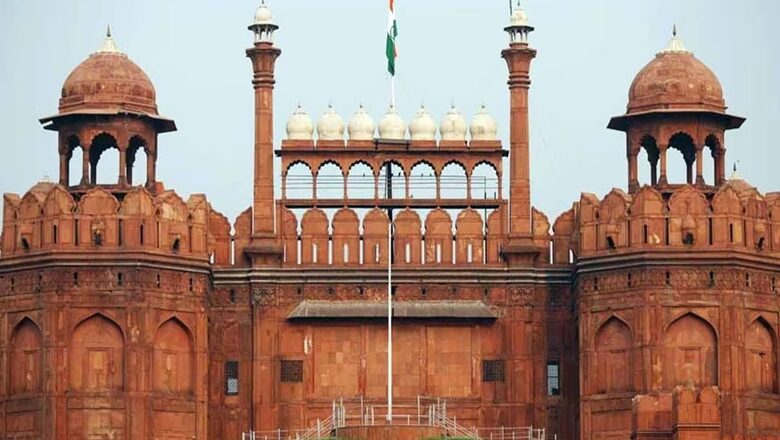
views
Another telling instance of Bahadur Shah Zafar’s reckless spending was the wedding celebrations of his favourite son, Mirza Jawan Bakht. It was touted as the “most important event of those days”. The wedding preparations began weeks prior to the actual date of marriage. Bahadur Shah Zafar took a loan of Rs 95,000 for the wedding from all sorts of creditors.
Betrothal, the Mehndi procession and the Chautah ceremonies were celebrated on a lavish scale. Pomp and pageantry were the order of the day on the streets of Delhi. Mirza Ghalib and Zauq composed congratulatory poems on the occasion and received fat honorariums. Huge sums of money were spent on the fireworks and illuminations. Dancing parties and musical concerts “increased the charm of the marriage”, observes the Precis of Palace Intelligence.
Bahadur Shah Zafar presented the bride with gold anklets, a pearl necklace, forehead ornaments and other jewellery. The bride’s father, Wali Dad Khan offered substantial dowry: 80 trays of clothings, two trays of jewellery, a golden canopy, scores of silver and copper utensils, four thousand rupees in cash, an elephant and four horses with embroidered trappings, two riding camels, etc.
If this was the path to bankruptcy personally paved by Bahadur Shah and his immediate family, his officialdom had devised its own methods to do the same.
Sale of Office to the Highest Bidder
Bahadur Shah’s personal physician, Hakim Ahsanulla Khan, exerted enormous clout. He was not only famed as a great physician of his times but was also Zafar’s Prime Minister. No important matter concerning the Court moved before he was consulted. He used to write the shuqas of the king and the king used to “affix his signet on them.”
The other powerful official was Mahboob Ali Khan, the Nazir (Chief Administrator). He was responsible for the distribution of the pension doled out by the East India Company and thus held the inhabitants of the Red Fort in his thrall. He could and did expel “all undesirable persons” from the Red Fort. The expulsion was regarded as extremely shameful, and there was no readmission.
Other important officers included the Kotwal of the Fort, the Mufti, the Qazi, the Mukhtar, the Mutsadi of the Jewels Office, the Captain of the Boys’ Battalion, the Mir Tuzak (Master of Ceremonies), Water Carriers, the Darwan of Nagar Khana, Shuqa writers, Chobdars and gardeners The English Clerk, George who translated Persian letters into English and vice versa, also commanded some influence.
Offices were sold to the highest bidder. The post of the Captain of the Boys’ Battalion was sold for Rs 2,200. A man named Janaki Das was appointed as the Mukthar of Begum Taj Mahal after he gave a bribe of Rs 2,000. This apart, every officer had to present a nazar (gift) on various festivals and on every occasion that Bahadur Shah passed by his house.
Judicial System
The king was the head of the judiciary assisted by the Kotwal, Qazi and Mufti. All the cases were sent to Zafar for final judgement. Weak, vacillating and indecisive by nature, Bahadur Shah naturally favoured compromises over hard verdicts except in two cases: (1) Gamblers were very severely punished. They were summarily thrown into prison and were heavily fined. (2) Wine-drinking was completely forbidden.
These impediments quite obviously birthed the underground economy. Instead of reducing, gambling and bootlegging actually flourished. The Precis lists the following crimes that were rampant in the city outside the Red Fort: Theft, wine-drinking, setting houses on fire, “abduction and enticing away of women”, forgery, corruption, embezzlement of money, suicide and “interfering in the privacy of others”.
Social Conditions
Just like how Bahadur Shah boasted of an opulent harem, his princes too, used to keep concubines and slave girls. On occasion, some of the slave girls were released from bondage and were allowed to marry whoever they liked.
Typically, the princes used to marry among their own families and the minimum dowry was fixed at five lakh rupees.
Divorce was discouraged while widow remarriage was encouraged.
Diet and Dress
The inmates of the Red Fort consumed prolific quantities of spices. Each month, the East India Company sent four large crates of spices from Calcutta.
As we noted earlier, although wine-drinking was prohibited in the Red Fort, most of its inhabitants smuggled the liquid with impunity. Their typical diet included fish, mutton, deer, pigeons, and rabbits. Goats and camels were sacrificed on Eid.
Bahadur Shah Zafar’s Princesses used to wear jewels, gold ornaments, and expensive clothes. Each prince had to present a nazar on the following occasions: his marriage, circumcision, departure from the fort for Mecca, Lucknow, Ajmer and other places. Zafar provided monetary aid for people going on the Hajj pilgrimage.
Amusements
Given this pervasive atmosphere of indulgence, wastefulness and non-productivity, Bahadur Shah’s princes emulated their father. Hunting was their most popular hobby. The Najafgarh Lake on the bank of the Yamuna was a favourite hunting spot.
Hunting apart, they enjoyed the company of nautch girls. They organised and funded bullfights, buffalo fights, ram-fights, cock-fights, dogs chasing jackals, flight of the pigeons, wrestling-matches, kite matches, and hare-hunting.
Other Sidelights
Bahadur Shah Zafar was a great believer of astrology. Sukhanand and Bismillah Beg were the chief astrologers of his court. He used to distribute alms on the occasions of the eclipses. He also had a great respect for Muslim Pirs and honoured Muslim saints of the past. He paid homage to the Dargahs of Qutub, Nizamuddin Auliya, Shah Mardan, etc.
Till the end, he desperately wanted to go on the Hajj pilgrimage but the British dissuaded him.
British Subsidy
The Precis of Palace Intelligence also makes an interesting revelation: “Things were very cheap in those days as it was subsidised by the pension of the British. A very good horse could be obtained for 200 rupees. Even elephants could be purchased for 250 rupees. Elephants used to have silver howdahs.”
“The main source of income of the princes was the pension given by the East India Company. Out of the pension given to the king, he used to allot a monthly allowance to various princes according to their relations with the king.”
“Some of the princes and princesses like Taj Mahal Begum were extravagant and had to borrow money and were under perpetual debt paying very heavy rates of interest.”
Closing Remarks
The picture of life inside Bahadur Shah Zafar’s Red Fort is clearly one of carefree living, profligate spending and decadence on an epic scale. All financed and therefore controlled by the East India Company ruling from Calcutta. To maintain just 2,000 people walled inside a large building. The fate of the people outside the walls was pretty much decided by Zafar’s officers available for sale to the highest bidder.
It was thus unsurprising that when the First War of Independence erupted in 1857, Bahadur Shah Zafar was singularly unprepared to lead it. In fact, he refused to lead it given the fact that he had displayed an active distaste for all things valorous and heroic. And the people responded in kind: with contempt. As the war erupted, commoners addressed Bahadur Shah Zafar with obscenities, taunted him as a cowardly budda (old man) and yanked his beard.
The Mughal Empire was snuffed out in a miserable prison in Burma where Zafar died of old age.
Concluded
The author is the founder and chief editor, The Dharma Dispatch. Views expressed in the above piece are personal and solely that of the author. They do not necessarily reflect News18’s views.



















Comments
0 comment